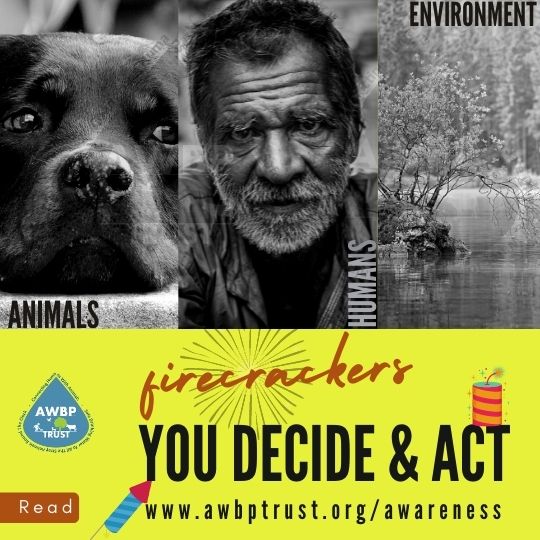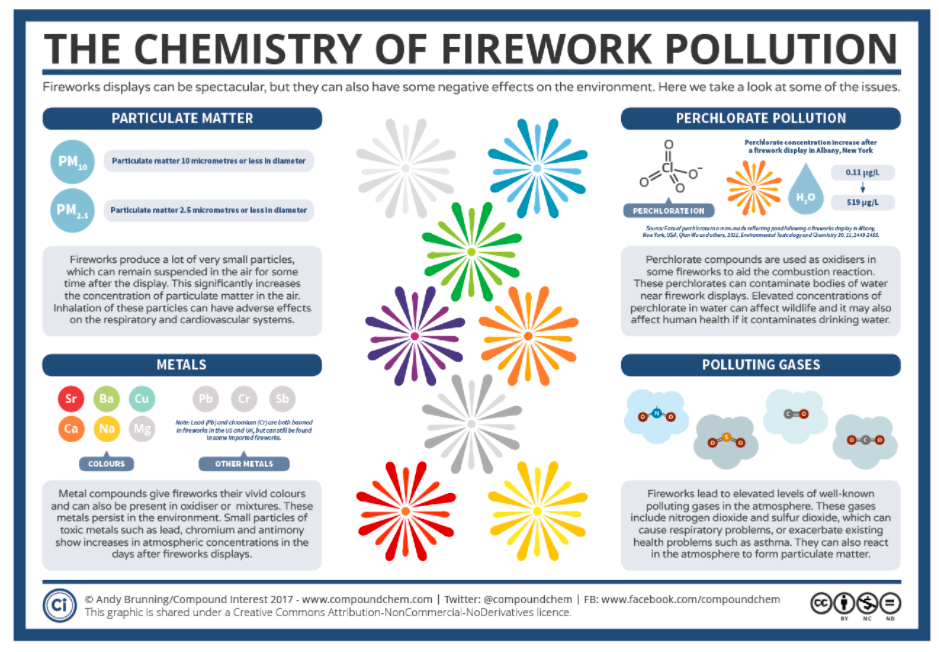People worldwide set off firecrackers during various occasions in India, Independence Day in the USA, Lantern Festival in China and Taiwan, Guy Fawkes in the UK, Christmas and New year celebrations in other countries across the world. We burn firecrackers on occasions like marriages, birthday parties, and sports competitions to celebrate our happiness as part of our tradition. But the fact is that the burning of firecrackers comes at a steep cost to us that leads to environmental damage, health hazards to humans and animals through various forms of pollution.
They affect the environment, badly!
Fireworks create highly toxic gases and pollutants that poison the air, the water, and the soil, making them harmful to birds, wildlife, pets, livestock, and people.

They pollute the air
Crackers pollute the environment with noise, particulate matter, and chemicals.
The regular firecrackers, when burst, emit toxic gases, chemical compounds in the forms of oxides of sulfur and nitrogen along with particulates which include chemicals like copper, zinc, sodium, lead, magnesium, cadmium, etc., which have a harmful bearing on human as well as environmental health.
They create damaging noise and land pollution
Loud cracker sounds can affect humans directly. Old age people can suffer from heart attacks due to choking loud sounds. During the explosion, these metal salts do not ‘burn up.’ They are still metal atoms, and many of them end up as aerosols that poison the air, the water, and the soil.
They contaminate water! Do you need a stronger reason?
When launched by us living around the nearby lakes and rivers, fireworks can contaminate waterways through the seeping of poisonous chemical compounds that can affect marine life and even kill them. The debris created by fireworks accumulates in the water bodies and chokes the plant and aquatic life.
A typical chemical released in fireworks is ammonium perchlorate, which is known to contaminate ground and surface waters and can cause harm to aquatic creatures residing in the lake. The chemicals of the fireworks that accumulate in water bodies led to an increase in cyanobacterial scums, a decrease in lake clarity, and an increase in algal blooms.
They tamper with the food chain
Persistent, Bioaccumulative, and Toxic Chemicals (PBTs) create their harmful effects. PBTs remain in the environment for very long periods, are highly resistant to degradation, and easily enter and quickly accumulate in the food chain.
In addition to posing an immediate health risk to humans, these pollutants can affect fish and other aquatic life and eventually move up the food chain.
A list of other potent reasons
Global Warming
Bursting crackers increase heat, carbon dioxide, and many toxic gases in the atmosphere, which causes a rise in the temperature of the earth and polluted air leading to global warming.
Fire Accidents
In the cracker market, a tiny spark can cause massive damage to the market, near residences and people available in that market; also, if not handled properly, it may cause injuries (internal – respiratory and external – burn).
Garbage
The leftover waste residues after the burning of firecrackers turn into debris that no one takes care of, and it affects the environment.
Chemicals In Firecrackers Affect Health
How?
The dangerous chemicals released during firework displays can wreak havoc on the human body, affecting the endocrine system, immune system, gastrointestinal system, and metabolism, as well as the neurotransmitters in the brain.
- Perchlorate, a chemical that is often mixed with sulfur and charcoal to create the gunpowder that makes fireworks explode, can inhibit the ability of the thyroid gland to derive iodine from blood (hypothyroidism). This can interfere with the production of thyroid hormones, which are essential to the metabolic and mental development processes. It can also lead to goiter and thyroid cancer.
- The tiny particles in firework smoke, known as particulate matter (PM), are harmful. Breathing them in can make you cough, irritate your lungs, and trigger asthma attacks. Particle pollution can also worsen existing lung diseases, and cause heart attacks, stroke, lung cancer and premature death.
- Strontium, a heavy metal used to produce the bright red colors in fireworks, has been linked to many serious health consequences, including congenital disabilities, damaged bone marrow, inhibited bone growth, anaemia, and impaired blood clotting.
- Some of the other chemicals dispersed by fireworks, such as aluminium, barium, cadmium, dioxins, and rubidium, are radioactive and known carcinogens. Exposure to these chemicals has been associated with many health conditions, including Alzheimer’s disease, dementia, bipolar disorder, depression, anxiety, heart disease, kidney disease, multiple sclerosis, rheumatoid arthritis, gastrointestinal disorders, and chronic fatigue.
- Crackers like the tiny sparklers, torches, and flower pots generate thick smoke that can affect the respiratory tract of young children.
- Firecrackers have much more severe effects on people with heart, respiratory or nervous system disorders.
- Inhaling fumes of crackers can increase the chances of an asthma attack. Heart patients and chronic bronchitis patients come under a high risk of episodes too.
- They can aggravate problems for people suffering from colds, allergies, or coughs and cause congestion of the throat and chest.
- They result in air pollution that creates carcinogenic Sulphur compounds and airborne arsenic effects.
- The green light produced in fireworks displays comes from barium, which is radioactive and poisonous. The blue color made from copper compounds comes from dioxins linked to cancer.
- When inhaled or ingested, these metals can cause a wide variety of short- and long-term reactions, ranging from vomiting, diarrhea, or asthma attacks, to kidney disease, cardiotoxic effects, and various cancers.
- The suspended particulate matter (SPM) levels rise significantly during festivities. This causes throat, nose, and eye-related problems, which can later develop into adverse health issues.
Effects of metals on Humans
Copper : Irritates the respiratory tract.
Cadmium : This leads to anaemia by reducing the capacity of blood to carry oxygen.
Zinc : Can cause metal fume fever and induce vomiting.
Lead : Harms the nervous system.
Magnesium: Metal fume fever is caused by Magnesium fumes.
Sodium: It is a highly reactive element and causes burns when it is combined with moisture.

Image Source – https://www.compoundchem.com/2017/01/05/fireworks-environment/
Bad Effects On Animals.
- The sound of bursting crackers can be pretty traumatic to pets, as they cannot bear loud sounds.
- Dogs have incredible hearing ability, and they can detect sounds that human beings cannot hear. Thus firecrackers with low decibels can affect their temperament.
- Animals feel scared and look for a safer place; the noise of firecrackers makes them unstable, leading to shivering, drooling, howling, psychosis, or excessive barking.
- Fireworks are terrifying for the various animals and dogs as the sounds cause high levels of anxiety and fear.
- The hearing of many animals is much more sensitive than it is in humans, so the explosions of fireworks are not only more disturbing to them, but they can damage their hearing more severely.
- A 2013 study by the University of Bristol’s School of Veterinary Sciences found fireworks were the most common trigger for fearful behavior in dogs. Responses included: trembling, shaking, hiding, seeking comfort, destruction, urination, and salivation.
What The Research Says About Effects Of Firecrackers?
Some places in China, the home of fireworks, also see sharp spikes in pollution after big celebrations. One 2017 study, for instance, found a 4- to 6-fold boost in air pollution within four hours of fireworks. And pollution levels didn’t fall back to normal for two to three days. This is as per the reports of a team led by Yang Song of Shandong University in Jinan, China.
One study found that fireworks create a “burst” of ozone (ref), an extremely reactive greenhouse gas molecule that can attack and irritate the lungs.
2007 study found that fireworks increased nitric oxide (NO) and sulfur dioxide (SO2) and also created and dispersed an aerosol cloud containing a variety of metallic elements (ref)
A 3-week study in London, spanning two major festivals that are celebrated with fireworks, found increased gas-phase pollutant levels of nitric oxide (NOx) and sulfur dioxide (SO2), which are primary contributors to acid rain as well as important climate change gases that also serve to irritate the lungs and throat.
This study also found elevated mass concentrations of fine particulates and trace concentrations of heavy metals, specifically strontium (Sr), magnesium (Mg), potassium (K), barium (Ba), and lead (Pb) (ref).
A case study found that within 1 hour of fireworks displays, strontium levels in the air increased 120 times, magnesium 22 times, barium 12 times, potassium 11 times, and copper (Cu) 6 times more than the amount already present in the air before the event (ref).
A 2010 study used epidemiological data to estimate the likely health impacts from fireworks pollution and found that the relative risk of cardiovascular mortality increased to as high as 125.11%. The relative risk for cardiovascular morbidity increased by 175.16% over a regular winter day (ref).
Countries That Banned Fireworks Across The World
The pollution-causing fireworks are entirely banned in a few countries. They are conditionally banned in other countries depending upon the country-specific laws and materials used to manufacture firecrackers.
| Country | Imposed Ban |
| Canada | Firecrackers are not authorized under the Explosives Act, thus making importation, possession, transportation, storage, or manufacturing illegal in Canada. |
| HongKong | Fireworks are banned for security reasons |
| Hungary | Firecrackers have been banned in Hungary since 2005. |
| Ireland | Fireworks and firecrackers are not permitted in the Republic of Ireland.Irish anti-firecracker laws are considered among the strictest in the world, equal to Chile’s. |
Conclusion
By choosing not to burn firecrackers, we can save the environment, plants, animals, and humans, thereby contributing to a green and healthy planet for all of us. We can choose to celebrate the occasions by feeding the street animals, adopting street animals, becoming a vegan by choice, supporting animal adoption centers through volunteering and other means, educating others about a sustainable lifestyle, and other activities that can be implemented which help humans, animals and the environment.
However, “The real change would come only by sensitizing people and bringing about a behavioral change while keeping in mind the sustainability of solutions offered” —R Suresh, Fellow, TERI.
Watch & Shareable Video Clips : Telugu | Hindi | English
Credits: Harish Edamadaka (Creative Content Writer), Lakshman Molleti (Content Designer & reviewer), Amritha Alapati (Content reviewer)
References
https://www.medicoverhospitals.in/how-firecrackers-affects-health/
https://lucknow.apollohospitals.com/how-crackers-affect-our-health.html
https://www.forbes.com/sites/grrlscientist/2019/12/31/festive-fireworks-create-harmful-pall-of-pollution/?sh=740bae0d2853
https://letmebreathe.in/
https://www.insightsonindia.com/2021/10/05/prohibited-chemicals-in-firecrackers/
https://www.robinage.com/environment/the-ill-effects-of-firecrackers.htm
https://www.lung.org/blog/fireworks-hidden-dangers#:~:text=The%20tiny%20particles%20in%20firework,lung%20cancer%20and%20premature%20death.
Effects on Animals
https://www.animal-ethics.org/how-fireworks-harm-nonhuman-animals/
https://www.forbes.com/sites/grrlscientist/2017/12/30/how-do-fireworks-harm-wild-birds/?sh=4b0ac207118c
https://www.fws.gov/midwest/news/IndependenceDay.html
https://www.rspca.org.uk/getinvolved/campaign/fireworks
Images MIT
https://www.compoundchem.com/2017/01/05/fireworks-environment/
https://www.compoundchem.com/2013/12/30/the-chemistry-of-fireworks/
